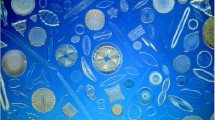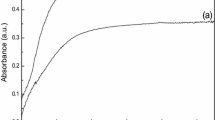Abstract
Biosilica from living diatom microalgae has recently attracted the interest of the scientific community and found several applications in bio-nanotechnology. Among silica-maker organisms, diatom microalgae represent the most attractive marine microorganisms, featuring highly hierarchical, nanotextured and porous silica walls. These biologic structures, known as “frustules” are also chemically addressable via simple chemical synthesis. In this work, we propose new diatom-based hybrid materials consisting of biosilica extracted from living Thalassiosira weissflogii coated with polydopamine (PDA) films. The adhesion properties of the PDA were exploited to decorate the silica surface with silver nanoparticles. These multifunctional heterostructures can be useful for applications ranging from bioelectronics to biomedicine.






Similar content being viewed by others
References
S.V. Patwardhan, N. Mukherjee, M. Steinitz-Kannan, and S.J. Clarson: Bioinspired synthesis of new silica structures. Chem. Commun. 10, 1122–1123 (2003).
F.M. Fernandes, T. Coradin, and C. Aimé: Self-assembly in biosilicification and biotemplated silica materials. Nanomaterials 4, 792–812 (2014).
W.E.G. Müller, and M.A. Grachev: Biosilica in Evolution, Morphogenesis, and Nanobiotechnology: Case Study Lake Baikal (Springer, 47, Berlin, 2009) Springer Science & Business Media, pp. 173–184.
E.G. Vrieling, W.W.C. Gieskes, and T.P.M. Beelen: Silicon deposition in diatoms: control by the pH inside the silicon deposition vesicle. J. Phycol. 35, 548–559 (1999).
E. De Tommasi, J. Gielis, and A. Rogato: Diatom frustule morphogenesis and function: a multidisciplinary survey. Mar. Genomics 35, 1–18 (2017).
R. Ragni, S.R. Cicco, D. Vona, G. Leone, and G.M. Farinola: Biosilica from diatoms microalgae: smart materials from bio-medicine to photonics. J. Mater. Res. 32, 279–291 (2017).
D. Vona, M. Lo Presti, S.R. Cicco, F. Palumbo, R. Ragni, and G.M. Farinola: Light emitting silica nanostructures by surface functionalization of diatom algae shells with a triethoxysilane-functionalized π-conjugated fluorophore. MRS Adv. 1, 3817–3823 (2015).
S.R. Cicco, D. Vona, R. Gristina, E. Sardella, R. Ragni, M. Lo Presti, and G.M. Farinola: Biosilica from living diatoms: investigations on biocompatibility of bare and chemically modified Thalassiosira weissflogii silica shells. Bioengineering 3, 1–19 (2016).
G. Leone, D. Vona, M. Lo Presti, L. Urbano, S. Cicco, R. Gristina, F. Palumbo, R. Ragni, and G.M. Farinola: Ca 2+-in vivo doped biosilica from living Thalassiosira weissflogii diatoms: investigation on Saos-2 biocompatibility. MRS Adv. 2, 1047–1058 (2017).
R. Ragni, F. Scotognella, D. Vona, L. Moretti, E. Altamura, G. Ceccone, D. Mehn, S.R. Cicco, F. Palumbo, G. Lanzani, and G.M. Farinola: Hybrid photonic nanostructures by in vivo incorporation of an organic fluorophore into diatom algae. Adv. Funct. Mater. 1706214, 1–9 (2018).
S.R. Cicco, D. Vona, E. De Giglio, S. Cometa, M. Mattioli Belmonte, F. Palumbo, R. Ragni, and G.M. Farinola: Chemically modified diatoms biosilica for bone cell growth with combined drug delivery and antioxidant properties. ChemPlusChem 80, 1104–1112 (2015).
R. Ragni, S.R. Cicco, D. Vona, and G.M. Farinola: Multiple routes to smart nanostructured materials from diatom microalgae: a chemical perspective. Adv. Mater. 1704289, 1–23 (2017).
D.R. Dreyer, D.J. Miller, B.D. Freeman, D.R. Paul, and C.W. Bielawski: Perspectives on poly(dopamine). Chem. Sci. 4, 3796–3802 (2013).
Q. Ye, F. Zhou, and W. Liu: Bioinspired catecholic chemistry for surface modification. Chem. Soc. Rev. 40, 4244–4258 (2011).
M. Yu, J. Hwang, and T.J. Deming: Role of L-3, 4-dihydroxyphenylalanine in mussel adhesive proteins. J. Amer. Chem. Soc. 121, 5825–5826 (1999).
H. Lee, S.M. Dellatore, W.M. Miller, and P.B. Messersmith: Mussel-inspired surface chemistry for multifunctional coatings. Science 318, 426–430 (2007).
C.C. Ho, and S.J. Ding: Dopamine-induced silica-polydopamine hybrids with controllable morphology. Chem. Commun. 50, 3602–3605 (2014).
M. Ambrico, P.F. Ambrico, T. Ligonzo, A. Cardone, S.R. Cicco, M. D’Ischia, and G.M. Farinola: From commercial tyrosine polymers to a tailored polydopamine platform: concepts, issues and challenges en route to melanin-based bioelectronics. J. Mater. Chem. C 3, 6413–6423 (2015).
J.J. Feng, P.P. Zhang, A.J. Wang, Q.C. Liao, J.L. Xi, and J.R. Chen: One-step synthesis of monodisperse polydopamine-coated silver core-shell nanostructures for enhanced photocatalysis. New J. Chem. 36, 148–154 (2012).
N. Wang, D. Zhang, X. Deng, Y. Sun, X. Wang, P. Ma, and D. Song: A novel surface plasmon resonance biosensor based on the PDA-AgNPs-PDA-Au film sensing platform for horse IgG detection. Spectrochim. Acta A: Mol. Biomol. Spectrosc. 191, 290–295 (2018).
Z. Yang, Y. Wu, J. Wang, B. Cao, and C.Y. Tang: In situ reduction of silver by polydopamine: a novel antimicrobial modification of a thin-film composite polyamide membrane. Environ. Sci. Technol. 50, 9543–9550 (2016).
G.H. Choi, D.K. Rhee, A.R. Park, M.J. Oh, S. Hong, J.J. Richardson, J. Guo, F. Caruso, and P.J. Yoo: Ag nanoparticle/polydopamine-coated inverse opals as highly efficient catalytic membranes. ACS Appl. Mater. Int. 8, 3250–3257 (2016).
M.V. Park, A.M. Neigh, J.P. Vermeulen, L.J. de la Fonteyne, H.W. Verharen, J.J. Briedé, and W.H. de Jong: The effect of particle size on the cytotoxicity, inflammation, developmental toxicity and genotoxicity of silver nanoparticles. Biomaterials 32, 9810–9817 (2011).
X. Chen, Y. Yan, M. Müllner, M.P. van Koeverden, K.F. Noi, W. Zhu, and F. Caruso: Engineering fluorescent poly(dopamine) capsules. Langmuir 30, 2921–2925 (2014).
L. Yanlan, A. Kelong, and L. Lehui: Polydopamine and its derivative materials: synthesis and promising applications in energy, environmental, and biomedical fields. Chem. Rev. 114, 5057–5115 (2014).
Q. Wei, F. Zhang, J. Li, B. Li, and C. Zhao: Oxidant-induced dopamine polymerization for multifunctional coatings. Polym. Chem. 1, 1430–1433 (2010).
I. Adamo, C. Ghisoli, and F. Caucia: A contribution to the study of FTIR spectra of opals. Neues Jb. Mineral. Abh. 187, 63–68 (2010).
R.A. Zangmeister, A. Todd. Morris, and M.J. Tarlov: Characterization of polydopamine thin films deposited at short times by autoxidation of dopamine. Langmuir 29, 8619–8628 (2013).
J. Natsuki, T. Natsuki, and Y. Hashimoto: A review of silver nanoparticles: synthesis methods, properties and applications. Int. J. Mater. Sci. Appl. 4, 325–332 (2015).
S.K. Srikar, D.D. Giri, D.B. Pal, P.K. Mishra, and S.N. Upadhyay: Green synthesis of silver nanoparticles: a review. Green Sustain. Chem. 6, 35–56 (2016).
Acknowledgments
For the design of the experiments and some important advices about interpretation of the analyses data, we thank Dr. F. Palumbo (CNR NANOTECH) and Dr. E. Altamura (Universita degli Studi di Bari).
Author information
Authors and Affiliations
Corresponding author
Supplementary material
Supplementary material
The supplementary material for this article can be found at {rs|https://doi.org/10.1557/mrc.2018.103|url|}.
Rights and permissions
About this article
Cite this article
Vona, D., Cicco, S.R., Ragni, R. et al. Biosilica/polydopamine/silver nanoparticles composites: new hybrid multifunctional heterostructures obtained by chemical modification of Thalassiosira weissflogii silica shells. MRS Communications 8, 911–917 (2018). https://doi.org/10.1557/mrc.2018.103
Received:
Accepted:
Published:
Issue Date:
DOI: https://doi.org/10.1557/mrc.2018.103




